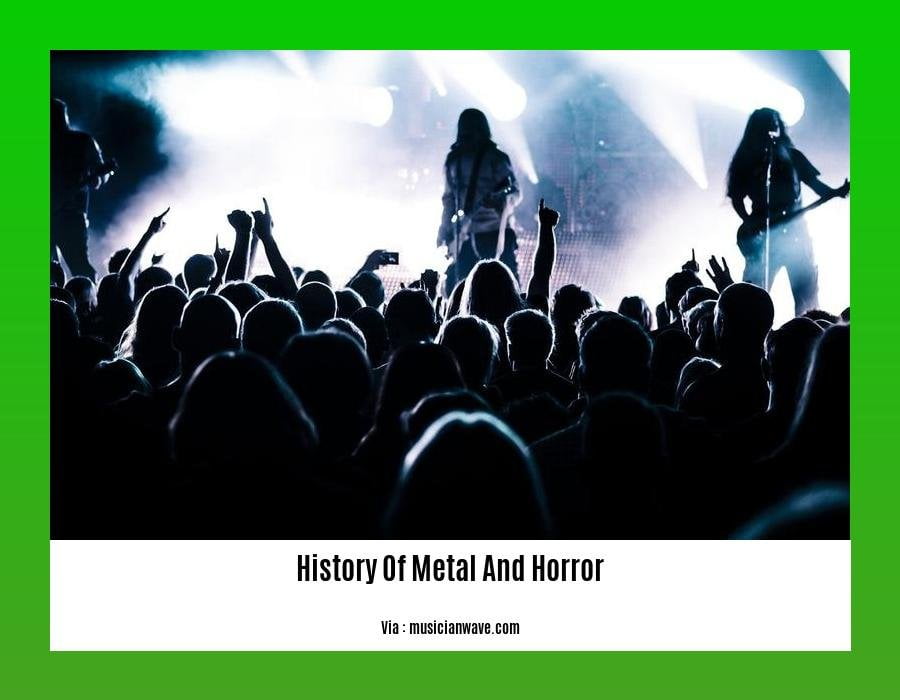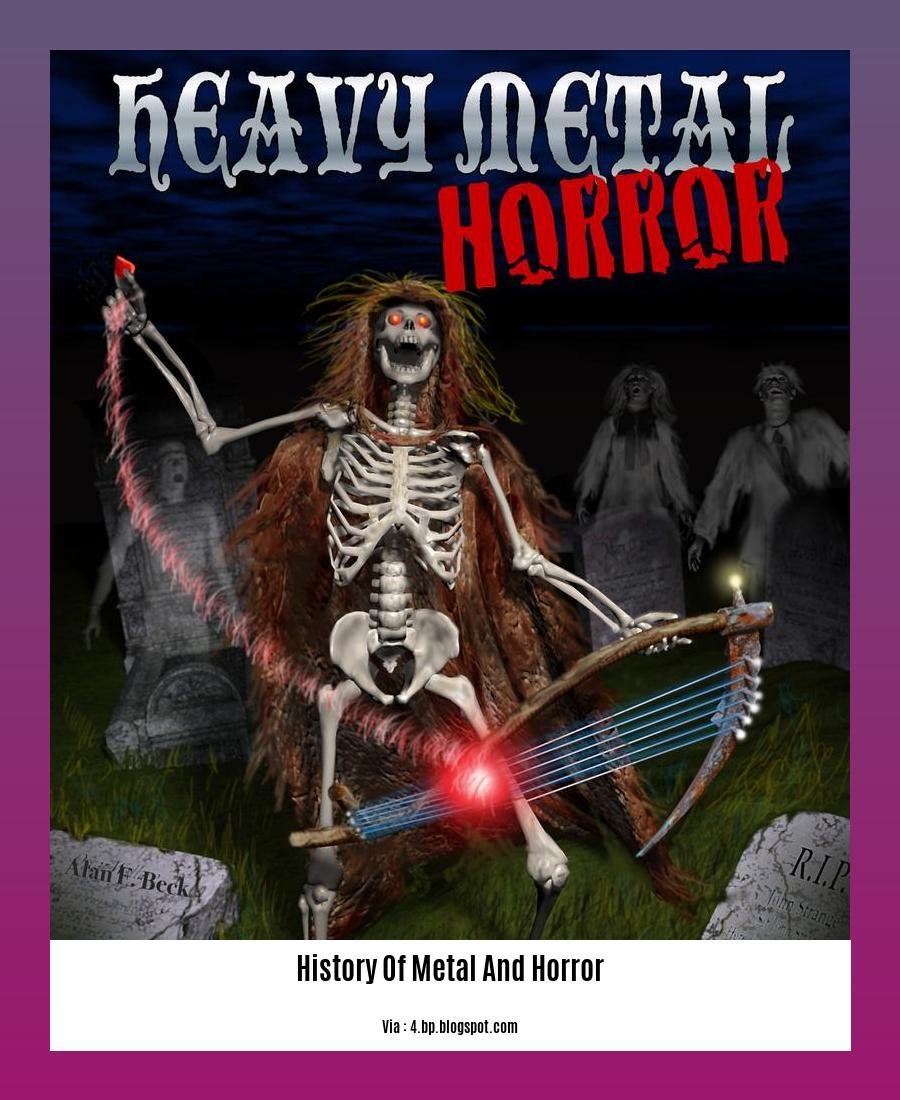[A Spine-Tingling Symphony: Exploring the Interwoven History of Metal and Horror] Metal and horror, two genres that at first glance may seem worlds apart, have forged an unholy alliance that has transcended decades, captivating audiences with their combined power to provoke, terrify, and inspire. Embark on a journey through the annals of history to uncover the spine-tingling symphony that has emerged from this unlikely union.
Key Takeaways:
- Genre Crossover: Heavy metal and horror share historical connections and influences.
- Artist Perspectives: Metal musicians share their experiences with horror and its impact on their music.
- Historical Context: The documentary traces the development of metal and horror, highlighting their convergence.
- Shared Themes: Both metal and horror explore themes of darkness, rebellion, and the supernatural.
History Of Metal And Horror

Prepare yourselves for a spine-tingling journey as we delve into the History Of Metal And Horror, where the eerie whispers of horror cinema intertwine with the thunderous riffs of heavy metal music. They may seem like two distinct realms, but they share an uncanny synergy that has left an indelible mark on popular culture.
The roots of this eerie alliance can be traced back to the 1970s, when the budding horror genre began experimenting with darker soundscapes. Bands like Black Sabbath emerged, their heavy riffs and haunting lyrics perfectly mirroring the unsettling imagery on the silver screen. Horror films, in turn, found their perfect soundtrack in the rebellious spirit and introspective nature of metal music.
Over the decades, this unholy union has blossomed into a thriving subculture. Metal bands like Slayer and Carcass embraced gore and macabre themes, while horror directors like John Carpenter and Rob Zombie drew inspiration from the raw energy of metal.
The History Of Metal And Horror is a testament to the power of darkness and storytelling. It’s a realm where fear and catharsis walk hand in hand, creating an unforgettable experience that continues to captivate and thrill audiences worldwide.
To learn more about the development of metal, you can read the history of metal article.
If you’re interested in the origins of metalworking, check out the history of metallurgy page.
For a comprehensive overview of the evolution of metal music, visit the history of metal music page.
To delve into the history of Metallica, follow the history of Metallica link.
If you want to explore the historical significance of metalworking, read the history of metalworking article.
To understand the evolution of metal detectors, visit the history of metal detectors page.
For a detailed timeline of metal’s history, visit the history of metals timeline page.
And finally, if you’re curious about documentaries on metal, check out our page on the history of metal documentary.
Notable Artists and Albums

In the realm where metal’s thunderous riffs collide with horror’s chilling whispers, a legion of notable artists and albums have emerged, leaving an indelible mark on both genres.
Black Sabbath (1970): The pioneers of doom metal, Black Sabbath’s self-titled debut album conjured an eerie atmosphere with its haunting lyrics and ominous riffs.
Slayer (1983): Thrash metal’s reign of terror, Slayer’s “Show No Mercy” unleashed a relentless assault of aggression and macabre themes.
Carcass (1988): Grindcore’s pioneers, Carcass’ “Reek of Putrefaction” pushed the boundaries of horror metal with its gruesome lyrics and sickening imagery.
Metallica (1986): Metal’s global icons, Metallica’s “Master of Puppets” seamlessly blended heavy metal with horror-inspired lyrics, creating a chilling masterpiece.
Rob Zombie (1998): The godfather of shock rock, Rob Zombie’s self-titled debut album combined metal’s intensity with B-movie horror aesthetics.
Key Takeaways:
- Black Sabbath paved the way for metal’s horror influences.
- Slayer’s intensity and gore set a new standard for metal horror.
- Carcass pushed the boundaries of extremity with their macabre themes.
- Metallica’s “Master of Puppets” became a horror metal landmark.
- Rob Zombie’s music and films merge metal and horror in a groundbreaking way.
Relevant URL Sources:
Impact on Cinema and Pop Culture
Picture a blood-curdling scream echoing through a darkened cinema, perfectly timed with the thunderous roar of heavy metal guitars. This is the captivating symphony that has long united the worlds of metal music and horror cinema.
Both genres tap into our deepest fears and primal instincts, creating an intoxicating brew that has left an indelible mark on pop culture. Metal’s menacing riffs and haunting lyrics provide the ideal soundtrack for horror’s macabre tales, while horror films have inspired metal bands to embrace themes of darkness, gore, and the supernatural.
This symbiotic relationship has fostered iconic collaborations like Metallica’s chilling score for “The Thing” and the visceral horror of Rob Zombie’s films, which draw heavily from metal’s raw energy.
Key Takeaways:
- Metal music and horror cinema share a mutual fascination with dark themes.
- Metal often provides the soundtrack for horror movies, enhancing their atmosphere and emotional impact.
- Horror films have influenced metal bands’ aesthetics, imagery, and lyrical content.
- The fusion of metal and horror has given rise to a thriving subculture and unique form of entertainment.
Relevant URL Sources:
Evolution and Contemporary Trends
In the subterranean realm where art meets darkness, two titans emerge: metal music and horror cinema. Their intertwined evolution mirrors the human psyche’s primal attraction to the macabre and the melodious.
Over the decades, the boundaries between these genres have blurred, creating a symphony of terror that captivates audiences. From Black Sabbath’s haunting riffs to Rob Zombie’s visceral films, metal and horror have found solace in each other.
Contemporary trends see metal bands like Ghost and Sleep Token embrace grand theatricality, while horror films like ‘The Babadook’ or ‘A Quiet Place’ employ metal-infused soundtracks. The fusion continues to innovate, blurring the lines and challenging artistic norms.
Key Takeaways:
- Metal music and horror cinema share a long history of influencing each other.
- Both genres explore dark themes like death, violence, and the supernatural.
- Metal bands often provide the soundtrack for horror films, creating an immersive atmosphere.
- Horror films have influenced metal bands’ aesthetics, imagery, and lyrics.
- Artists from both fields collaborate on projects that blend metal and horror sensibilities.
Relevant URL Sources:
רבה
- Sept 31 Myth: Unveiling Calendar Secrets - March 18, 2025
- How Long & Till December 18, 2025: Accurate Countdown Guide - March 18, 2025
- Discover Japanese Artists: A Complete History - March 18, 2025
















